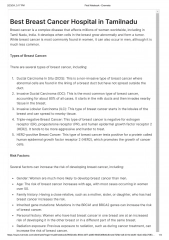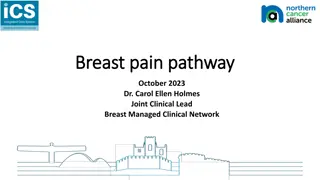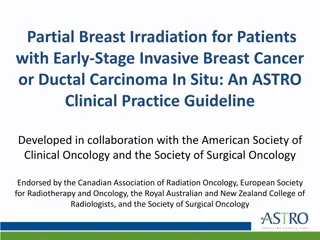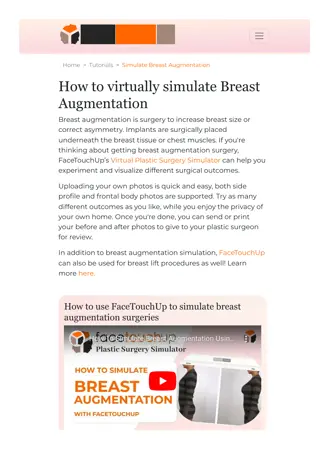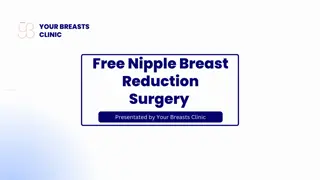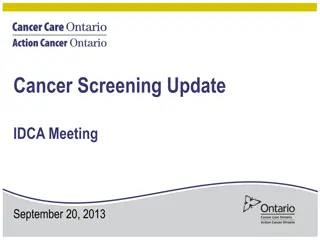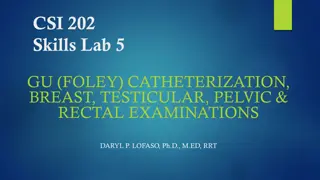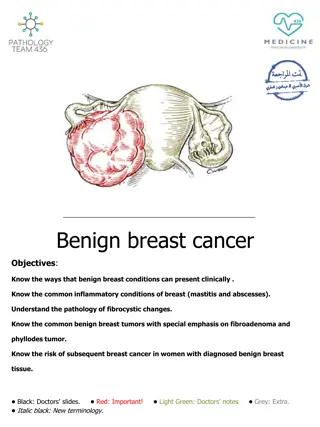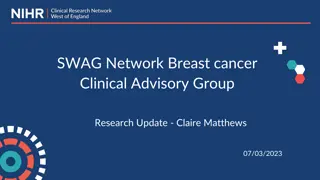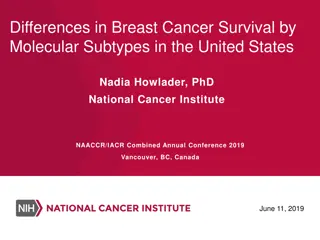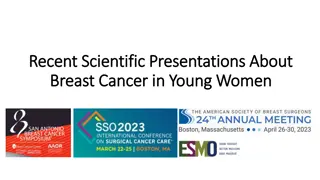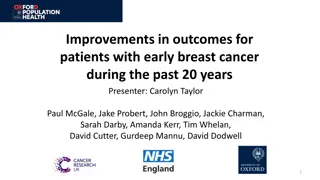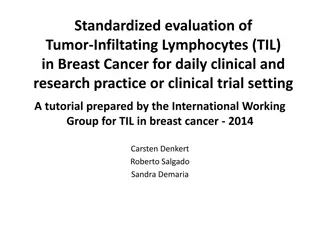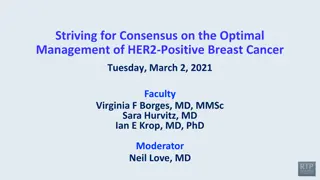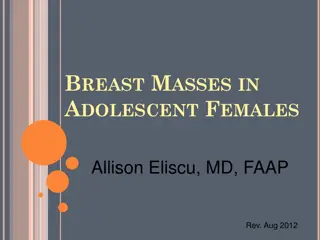Breast Development and Changes in Females
The breast, a vital organ in the upper ventral region of the torso, undergoes significant changes during puberty, the menstrual cycle, pregnancy, and milk production. These changes are driven by hormonal fluctuations, primarily estrogen and progesterone, resulting in the growth of milk ducts, formation of milk glands, and readiness for lactation. Understanding these processes is crucial for women's health and reproductive well-being.
Download Presentation

Please find below an Image/Link to download the presentation.
The content on the website is provided AS IS for your information and personal use only. It may not be sold, licensed, or shared on other websites without obtaining consent from the author.If you encounter any issues during the download, it is possible that the publisher has removed the file from their server.
You are allowed to download the files provided on this website for personal or commercial use, subject to the condition that they are used lawfully. All files are the property of their respective owners.
The content on the website is provided AS IS for your information and personal use only. It may not be sold, licensed, or shared on other websites without obtaining consent from the author.
E N D
Presentation Transcript
Introduction The breast is one of two important located on the upper ventral region of the torso of primates. In females, it serves as the mammary gland, which produces and secretes milk and feeds infants.
At puberty As a girl approaches her teen years, the first visible signs of breast development begin. When the ovaries start to produce and release (secrete) estrogen, fat in the connective tissue starts to collect. This causes the breasts to enlarge..
The duct system also starts to grow. Often these breast changes happen at the same that pubic hair and armpit hair appear
At menstrual cycle Each month, women go through changes in the hormones that make up the normal menstrual cycle. The hormone estrogen is produced by the ovaries in the first half of the menstrual cycle..
It stimulates the growth of milk ducts in the breasts. The increasing level of estrogen leads to ovulation halfway through the cycle. Next, the hormone progesterone takes over in the second half of the cycle.
It stimulates the formation of the milk glands. These hormones are believed to be responsible for the cyclical changes that many women feel in their breasts just before menstruation. These include swelling, pain, and soreness
During pregnancy and milk production Breast changes are one of the earliest signs of pregnancy. This is a result of the hormone progesterone. In addition, the dark areas of skin around the nipples (the areolas) begin to swell. This is followed by the rapid swelling of the breasts themselves.
Most pregnant women feel soreness down the sides of the breasts, and nipple tingling or soreness. This is because of the growth of the milk duct system and the formation of many more lobules. By the fifth or sixth month of pregnancy, the breasts are fully capable of producing milk. As in puberty, estrogen controls the growth of the ducts, and progesterone controls the growth of the glandular buds.
Many other hormones also play vital roles in milk production. These include (FSH), (LH), prolactin, oxytocin, and human placental lactogen (HPL). blood vessels in the breast becoming more visible and the areola getting larger and darker. All of these changes are in preparation for breastfeeding the baby after birth.
What happens to the breasts at menopause? By the time a woman reaches her late 40s and early 50s, perimenopause is starting or is well underway. At this time : the levels of estrogen and progesterone begin to change. Estrogen levels dramatically decrease. This leads to many of the symptoms commonly linked to menopause.
Without estrogen, the breasts connective tissue becomes dehydrated and is no longer elastic. The breast tissue, which was prepared to make milk, shrinks and loses shape. This leads to the "saggy" breasts associated with women of this age.
Anatomy and physiology of the breast Made up of milk-producing glands Supported and attached to the chest wall by ligaments Rests on pectoralis major muscle Three major hormones affect the breast Estrogen, progesterone , and prolactin
Breast contains 15-20 lobes Fat covers the lobes and shapes the breast Lobules fill each lobe Sacs at the end of lobules produce milk Ducts deliver milk to the Nipple
function of the breast 1- The breast produces milk which serves to nutrition for infants. It provides complete nutrition for the newborn baby and contains carbohydrate (lactose), fats and proteins as well as micronutrients. as well as offering immunological protection to the newborn baby.
2- Female breasts have social (body image) and sexual characteristics. especially the nipples is an erogenous zone on women.
Normal changes of the breast 1- breasts are slightly different sizes. 2- One breast hangs slightly lower than the other. 3- You have hair around your nipples. 4- breasts hurt or feel tender before and during period. .
Some common problems of the breast: 1- Inverted or flat nipples Nipples are considered flat if they don't stand out much from the surrounding area (areola) and don't protrude when stimulated.
3- Breast (Venous) engorgement: is when the breast tissue overfills with milk, blood and other fluids. This causes the breasts to feel very full, to become hard and painful and the nipples appear flattened and tight
Management and treatment Nonmedical method The mother must remove the breast milk. If the baby can attach well and suckle, then she should breastfeed as frequently as the baby is willing. If the baby is not able to attach and suckle effectively, she should express her milk by hand or with a pump a few times until the breasts are softer, so that the baby can attach better, and then get them to breastfeed frequently.
apply warm compresses to the breast or take a warm shower before expressing, which helps the milk to flow. use cold compresses after feeding or expressing, which helps to reduce the oedema.
medical methods are proteolytic enzymes such as serrapeptase, protease, and subcutaneous oxytocin.
4- Milk engorgement: This may occur as milk comes in and is relieved by allowing baby to feed frequently.
5- Mastitis is an infection in the tissue of one or both of the mammary glands inside the breasts. It usually affects women who are producing milk and breast-feeding.. There is often a hard, sore spot inside the breast. This can result from a blocked milk duct or because bacteria enter the breast through a break in the skin.
Sometimes, it can affect women who are not lactating, but it is uncommon. In very rare cases, it can affect men.
Symptoms an area of the breast becoming red and swollen the affected area of the breast hurting when touched the affected area feeling hot when touched a burning sensation in the breast that may always be there or only when breast-feeding flu-like symptoms
The following symptoms may be present: anxiety and feeling stressed chills and shivering elevated body temperature fatigue general aches and pains a feeling of malaise
management and treatment Staying hydrated. Getting plenty of rest. Continuing to breastfeed the baby, making sure that he or she is correctly attached to the breast. Taking over-the-counter pain relievers such as ibuprofen (with a doctor s approval) to help reduce fever or pain.
Expressing milk from the breast, if needed. Sometimes need Oral Antibiotics , Amoxicillin/clavulanate (Augmentin), 875 mg twice daily
8- Over supply: Sometimes initial milk supply is much more than baby requires and this may lead to engorgement and mastitis.
Care of the breast (Postnatal care) 1- Always wash your hands prior to feeds to prevent potential infection however; there is no need to wash the nipples before feeds. 2- Avoid soap, alcohol based products or creams on your breasts/nipples as these will not prevent nipple damage and in some cases may increase the risk of damage to the nipples.
3- Allow breast milk to dry on your nipples as it has natural antibacterial and healing properties. 4- Wear a comfortable, supportive bra when lactation is established. Ensure the bra is not too tight to prevent pressure on the milk ducts which may lead to mastitis.
Abnormal changes of the breast 1-Afirm lump you've never felt before. 2- Swelling around your breast, collarbone, or armpit. 3- Dry, cracked, red, or thickened skin (like an orange peel) around nipple. 4- Blood or fluid (besides milk) leaking from nipples. 5- Warmth or itching in breasts.
These symptoms don't always mean something's wrong, but it's important to get checked out by a doctor. They may be harmless changes, or they may be caused by an irritation or infection that can be easily treated. Rarely, they can be signs of cancer.
Breast health knowing your own breasts how they look and feel begins with a sense of what's normal for breasts (breast awareness). To promote breast health, consider doing regular breast self-exams. With practice, 'll discover how breasts vary in sensitivity and texture at different times during menstrual cycle.
For many women, breast health includes concerns about breast lumps, breast pain or nipple discharge. It's also important to understand common screening and diagnostic tests for breast health, such as clinical breast exams, mammograms and breast ultrasounds.
Methods of Breast Examination 1- Clinical Breast Exam (CBE) once a year 2- Screening mammogram every year for women aged 40-49 3- Screening mammogram every one to two years for women 50 and over. 4- Computer aided detection (CAD).
6-Breast ultrasound (ultrasonography). 7-magnetic resonance imaging (MRI).
Methods of the clinical breast examination 1- Inspect ( relaxed, arms raised, hand on hips) Breast symmetry skin changes (edema, ulceration) nipples (retraction, discharge).
2-Palpation ask the patient to lie flat and stand at the patient's right side, place a small pillow under the shoulder with ipsilateral arm above head spreads the breast more evenly across chest warm your hands and keep conversing with patient to make them comfortable
palpate breasts with both the flat of your hand and fingers. with flat fingers compress breast tissue follow systematically, in a circular pattern around the nipple or along the radial lines (simulate a clock) or vertical segments and feel the entire breast, including the tail near the axilla. consistency of tissue fat (soft) and gland (lumpy) firm transverse ridge along lower edge


